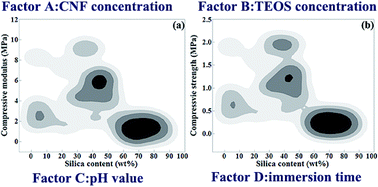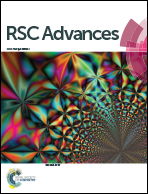Cellulose nanofibril reinforced silica aerogels: optimization of the preparation process evaluated by a response surface methodology†
Abstract
Cellulose nanofibrils (CNF) were used to reinforce silica aerogels, aiming to ameliorate the aerogels' inherent brittleness. The CNF-reinforced silica aerogels were prepared through the elaboration of silica particles interpenetrated with a nanocellulosic network structure by immersion of the CNF aerogels into a silica solution in a two-step sol–gel process (first, hydrolysis of tetraethyl orthosilicate (TEOS) and second, condensation under alkaline conditions). The relationships among the silica content, the density, and the compressive properties of the composite aerogels were investigated. A response surface methodology (RSM) was applied to optimize the preparation process (CNF concentration, TEOS concentration, pH value of condensation process and immersion time) with the target being to synthesize a desired aerogel with improved mechanical properties. The results show that density can be seen as a function of the silica content, and that the two had a positive dependent relationship. The compressive properties were also greatly affected by the silica loading into the cellulosic scaffold. The composite aerogel displayed high compressive properties at 40–50 wt% silica particles. The optimal condition would be a CNF aerogel of 5% solid content immersed into a 2.5 mol L−1 TEOS sol with condensation at pH value of 10 for 10 min. The compressive modulus (6.57 MPa) and compressive strength (1.37 MPa) of the composite aerogel greatly exceeded those of the pure silica aerogel, without substantial increases in density (0.1 g cm−3). The composite aerogel also had good insulation properties (thermal conductivity was 0.0226 W m−1 K−1) and hydrophobicity (contact angle 152.1°) and thus can be considered as a multi-functional aerogel capable of applications in a wide variety of areas.


 Please wait while we load your content...
Please wait while we load your content...